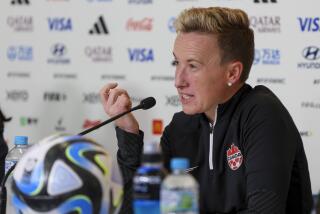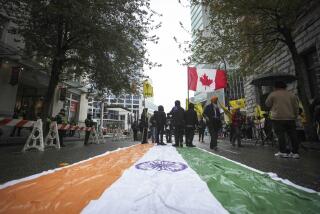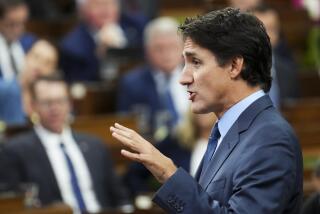Canadian Peacekeeping Is Under the Gun
OTTAWA — Many national capitals erect monuments to sons and daughters who have died in war; Ottawa memorializes those who have died for peace.
The monument--pale stonework graced by three bronze sentinels facing the horizon--pays tribute to Canadians in uniform who for 50 years have separated warring factions, maintained truces, sheltered the defenseless and sometimes lost their lives in U.N. peacekeeping operations on five continents.
Canadians like to believe that their peacekeeping service reflects that which is best and most salient in the national character: self-sacrifice, dedication to the common good, compassion for the least fortunate.
But shocking disclosures of abuse by Canadian peacekeepers in Somalia and the Balkans--including murder, torture, racism, profiteering and assaults on mental patients--are undermining that proud tradition, exposing the decay within Canada’s military establishment and eroding the reliability of the United States’ longtime defense partner.
Reports of misconduct by peacekeepers--and of efforts by high-ranking officers to cover it up--have been building for three years, leading to a crisis in the 64,000-member armed forces that many say parallels the one faced by the U.S. military after the Vietnam War.
The government of Prime Minister Jean Chretien has responded by referring each new revelation to a special commission of inquiry, which since October has been hacking its way through a thicket of conflicting accounts, shredded documents and self-exculpating explanations offered up by witnesses.
The latest reports suggest that the panel might not complete its work until 1998.
A breakthrough of sorts may have been achieved last month, however, when Lt. Gen. Maurice Baril, the commander of Canada’s army, strode past a lineup of army brass in Montreal and declared to reporters that “an unacceptably high number of cases of misconduct across the whole army . . . are directly traceable to failures of leadership.”
“The army has a significant leadership deficiency, and I intend to both address it and rectify it forthrightly,” Baril said.
With that, Baril echoed what many critics have been saying--that there is, to quote Scott Taylor, publisher of the muckraking military journal Esprit de Corps, “rot” at the heart of Canada’s officer corps.
Baril was moved to action by recent revelations that transformed what seemed like a selfless rescue by Canadian troops into another painful scandal.
In the fall of 1993, a battalion of Canadian peacekeepers on U.N. duty in Bosnia-Herzegovina arrived at an isolated and dilapidated mental hospital in Bakovici, where they encountered 300 starving patients.
Through the spring of the following year, a rotating unit of 40 men protected the hospital staff and patients and were lionized as heroes by the Canadian media.
Soon afterward, however, disturbing reports about Bakovici began to surface within the army: tales of drunken parties, sexual liaisons with nurses and interpreters, attacks on patients and black-market transactions that included sale of a .50-caliber machine gun to a Bosnian Croat militia.
There were 12 military police reports on the allegations, but no charges were brought.
In January, after Esprit de Corps reported the allegations, an army spokesman said they had been investigated and disproved.
But Baril said new evidence has identified 34 soldiers who face disciplinary action for alcohol abuse, sexual misconduct, black-market activities and violence against patients in Bakovici.
The revelations followed the disturbing saga of the Canadian Airborne Regiment, a special-forces unit deployed to Somalia in 1992 as part of the U.N. relief effort there.
Harassed by Somalis who sneaked into the camp to steal supplies, the unit’s commander gave soldiers permission to fire on intruders. One Somali was shot to death, and another, a 16-year-old boy, was captured and tortured to death.
Disclosure of the fatal beating--recorded in grisly souvenir photographs taken by members of the regiment--shocked the Canadian public in 1993 and led to appointment of the commission of inquiry.
But that was just the beginning.
Homemade videotapes of Airborne soldiers making racist remarks and engaging in brutal and degrading hazing rituals appeared on national television last year, prompting Defense Minister David M. Collenette to disband the unit. It marked the end of a military tradition that traced its lineage to the Canadian paratroopers who were dropped behind German lines for the D-day invasion in 1944.
More recently, the scandal has moved up the military ladder. There are accusations that high-ranking officers, perhaps including Gen. Jean Boyle, the military chief of staff, tried to block public inquiry into the Somalia operation by altering or destroying documents sought by the media.
The series of shock waves has forced the Canadian public to focus attention on an institution usually taken for granted: the armed forces.
Despite a distinguished record in two world wars and Korea, the Canadian military has gradually dwindled in size and influence over the last four decades. But it developed a specialty in U.N. peacekeeping, inspired by the award of the 1957 Nobel Peace Prize to Lester B. Pearson, the Canadian prime minister credited with launching the first such mission.
Canada boasts that it is the only nation to have participated in every U.N. deployment, even if its soldiers often roll up in armored personnel carriers so old they cannot stop a modern rifle bullet.
While its altruistic aspects are undeniable, Canadian peacekeeping has also served as a domestic political convenience and a self-congratulatory national myth, experts say.
“It was a good way for us to tell our allies we were doing something useful for them even if we couldn’t contribute much to NATO, and we got as much mileage out of that as we could. The Canadian public liked peacekeeping because they could say: ‘We’re keeping the peace while you Americans fight wars. You invade Grenada and we keep the peace. We’re different and, by implication, better than you,’ ” said Jack Granatstein, a historian who specializes in international diplomacy.
But Nicholas Stethem, a Toronto-based defense analyst, notes the widening gap between the peacekeeping ideal embraced by the public and the reality encountered by the soldiers.
“The Canadian peacekeeping icon is when you have two guys who agree to stop fighting and you agree to stand between them,” he said. “Nobody gets killed, and everybody sees you as the golden good guy.”
In Somalia and Bosnia, as well as elsewhere, “the reality has been messy,” Stethem added. “In the Balkans, there is no good guy.”
Publisher Scott said Canadians hold a mental picture of their soldiers “giving out teddy bears to kids and handing out food,” when in fact they may be huddled in a dugout under fire from a local militia. Moreover, Canada’s chronic staffing shortages and poor equipment further strain forces.
The chasm between Canada’s peacekeeping imagery and the facts is most evident in the history of the Airborne Regiment.
Testimony before the commission of inquiry has indicated that regimental commanders were reluctant to confront problems in the ranks. The one officer who complained to superiors about disciplinary problems was promptly transferred.
Similar attitudes are pervasive in the officer corps, according to analysts.
“You don’t get points for standing up on your hind legs and saying, ‘This is wrong.’ You get points for being a ‘team player,’ ” Stethem said.
One result is a dramatic drop in morale and confidence among enlisted personnel, according to Maj. C.R. Shelley, assistant professor of military psychology and leadership at the Royal Military College of Canada.
“I get the impression that a lot of people are losing respect for the higher ranks. They see a general and assume he couldn’t have gotten there without being unethical or being more of a politician,” he said.
The problem may be exacerbated by what critics call Canada’s bloated officer corps. Officers account for 22% of Canada’s military personnel, compared with 15.7% in the United States. Canada’s air force includes 32 generals among its 24,499 men and women and puts only 60 combat jets into the sky.
Military and political analysts are divided over whether the Chretien government will effect serious reform.
But the series of scandals already is affecting Canada’s participation in international security missions.
When North Atlantic Treaty Organization troops replaced the U.N. forces in the Balkans last year, Canada offered only a token force of 1,000 and deployed the troops in an area where they were unlikely to encounter hostility.
More to Read
Sign up for Essential California
The most important California stories and recommendations in your inbox every morning.
You may occasionally receive promotional content from the Los Angeles Times.









